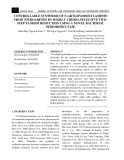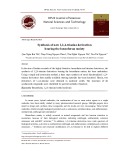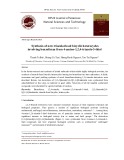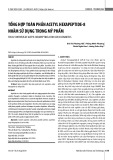
HPU2. Nat. Sci. Tech. Vol 02, issue 02 (2023), 59-67
HPU2 Journal of Sciences:
Natural Sciences and Technology
journal homepage: https://sj.hpu2.edu.vn
Article type: Research article
Received date: 16-8-2023 ; Revised date: 31-8-2023 ; Accepted date: 31-8-2023
This is licensed under the CC BY-NC-ND 4.0
Green synthesis of UV absorber (E)-2-(((4-
(benzyloxy)phenyl)imino)methyl)phenol by microwave method
Kieu-Khanh Nguyen Thi
a
, Anh-Thu Nguyen
a
, Anh-Vu Ho Pham
a,*
, Viet-Hai Le
b
,
Ngoc-An Nguyen
a
, Thanh-Nguyen Huynh Le
a
, Thanh-Thien Co
a
,
Hoang-Thai Nguyen
a
, That-Quang Ton
a
a
Faculty of Chemistry, University of Science (UoS), Vietnam National University Ho Chi Minh City (VNU-
HCM), 227 Nguyen Van Cu, District 5, HoChiMinh City, Vietnam
b
Faculty of Materials Science and Technology, University of Science (UoS), Vietnam National University Ho
Chi Minh City (VNU-HCM), 227 Nguyen Van Cu, District 5, HoChiMinh City, Vietnam
Abstract
In this work, a UV absorber compound (E)-2-(((4-(benzyloxy)phenyl)imino)methyl)phenol was
synthesized by microwave method using a two steps protocol. In the first step, α-(4-
hydroxyphenylimino)-o-cresol (1) was synthesized from 4-aminophenol and salicylaldehyde by
circulating under microwave heating at 60
o
C for 8 minutes, the reaction yield reached 82.91 %. In the
second step (E)-2-(((4-(benzyloxy)phenyl)imino)methyl)phenol (2) was synthesized from precursor
(1) and benzyl bromide by circulating under microwave heating at 80
o
C for 3 minutes, the reaction
yield reached 25.08 %. The overall yield for the synthesis of UV absorber 2 was 20.79 %. The
molecular structures of precursor (1) and product (2) were analysed by high performance liquid
chromatography - mass spectrometry (LC/MS) and nuclear magnetic resonance (NMR) methods. The
UV absorbance of precursor (1) and product (2) was investigated by UV absorption spectrometry. The
obtained results show that product (2) has a higher UV absorption intensity than precursor (1), the UV
absorption region extends from 240 nm to 390 nm, the maximum absorption peak is at the wavelength
(λ
max
) of 350 nm. The UV absorber (E)-2-(((4-(benzyloxy)phenyl)imino)methyl)phenol with cyclic
structure, low molecular weight, and high UV absorbance has potential application as an UV absorber
for greenhouse covering plastic, paint and ink systems.
Keywords: UV stabilizer, UV absorber, microwave method, green chemistry.
* Corresponding author, E-mail: hpavu@hcmus.edu.vn
https://doi.org/10.56764/hpu2.jos.2023.2.2.59-67

HPU2. Nat. Sci. Tech. 2023, 2(2), 59-67
https://sj.hpu2.edu.vn 60
1. Introduction
Polymer materials are increasingly used in daily life, they have been widely used in various fields
and have gradually replaced materials such as glass, paper, and wood [1]. However, under the
conditions of use, when exposed to various environmental factors such as temperature, light radiation,
water, chemicals and air, polymeric materials tend to degrade and lose their physical and mechanical
properties, causing the color change [2]. The destruction of polymeric materials under UV irradiation
is closely related to the chemical bond strength of the polymer backbone and the energy of the UV
light. UV radiation energy with wavelengths between 300 and 400 nm could break bonds in polymeric
materials. The polymer molecules change from the ground state to the excited state. When the energy
is large enough, it will activate for chemical reactions to take place, C - C, C - H, C - X bonds are
broken, leading to polymer degradation [2-4]. The most effective solution to improve the weather
resistance of polymer-based products (such as greenhouse membranes, printing inks, coatings) is to
use UV-resistant additives [4,5]. These additives improve the UV stability of the polymeric materials
under UV exposure conditions, thereby increasing the durability of the polymers. A UV stabilizer is a
substance that prevents or slows the degradation of polymeric materials when exposed to ultraviolet
light. Commercially available UV stabilizers can be divided according to their origin (inorganic and
organic) or their protection mechanism (UV absorbers, quenching agents, and free radical scavengers)
[5,6]. Additionally, UV stabilizers must meet other requirements such as less change in polymer
properties, less impact on aesthetics, high solubility in polymers and not released during use, high heat
resistant and does not evaporate or decompose during machining, odorless, tasteless, and non-toxic
[2,3]. The need to use high-performance UV absorbers meeting increasingly demanding criteria
therefore requires constant research and development efforts for new UV absorbers.
In this study, low molecular weight UV (E)-2-(((4-(benzyloxy)phenyl)imino)methyl)phenol was
green-synthesized by microwave method and investigated its applicability as a UV absorber for
polymers. Belonging to the Schiff base structure, compound 1 was synthesized and further modified in
its chemical structure (product 2) to improve its UV absorption capacity. The use of Schiff bases as the
organic UV absorbers is well demonstrated in numerous reports in the literature [7-10]. The UV
protection mechanism of Schiff base linked to their enol - keto transformation during UV absorption
[11-12].
2. Experimental
2.1. Chemicals
Salicylaldehyde (99%), 4-aminophenol (99%), toluene (99%), and benzyl bromide (99%) were
purchased from Merck (Germany). Ethanol (99.5%) and N,N-dimethylformamide (DMF) were
provided by Chemsol (Vietnam).
2.2. Synthesis of UV absorber
The UV absorber (E)-2-(((4-(benzyloxy)phenyl)imino)methyl)phenol was synthesized by the
microwave method using a modified Sharp R-218lW microwave oven followed a two-step process as
shown in the schematic diagram in Figure 1.

HPU2. Nat. Sci. Tech. 2023, 2(2), 59-67
https://sj.hpu2.edu.vn 61
HO
NH2
OH
N
OH
OH
N
O
Salicylaldehyde
Microwave
(Low), 8 min NaOH
Microwave (Medlow)
3 min
Ethanol
Benzyl
bromide
1(H = 82.91%)
2(H = 25.08%)
Figure 1: Synthesis of UV absorber (E)-2-(((4-(benzyloxy)phenyl)imino)methyl)phenol.
Synthesis of precursor α-(4-hydroxyphenylimino)-o-cresol
The precursor α-(4-hydroxyphenylimino)-o-cresol (1) is synthesized from 4-aminophenol and
salicylaldehyde. Accordingly, dissolve 6.5397 g of the 4-aminophenol in 80 mL of absolute ethanol,
then add 6.30 mL of salicylaldehyde to this solution. Circulate the reaction mixture in a microwave
oven at 60 °C for 8 min using the low power level setting. After the reaction, the solution was allowed
to cool at room temperature. Crystallize the product by slowly adding the reactant solution to 700 mL
of distilled water under stirring (300 rpm) to form yellow-orange crystals. Filter for crystals and purify
the product by dissolution/recrystallization in distilled water (700 mL), in ethanol (80 mL), and DMF
(30 mL), sequentially. The purified product was vacuum-dried for 2 hours at 60 °C to obtain 10.5965 g
of the precursor product (1) orange yellow, fine powder, with a reaction yield (H) of 82.91 %.
Synthesis of UV absorber (E)-2-(((4-(benzyloxy)phenyl)imino)methyl)phenol
UV absorber (2) was synthesized from precursor (1) according to the following procedure:
Dissolve 2.1305 g of precursor (1) in 30.0 mL of ethanol to obtain solution A. Dissolve 0.2065 g
NaOH to 20 mL ethanol yields solution B. Transfer solutions A and B to a 500 mL flask, add to the
mixture 1.20 mL benzyl bromide and perform the reaction at 80 °C in the microwave oven for 3 min
using the medium power level setting. After the reaction, let the mixture cool to room temperature.
The product that crystallized at room temperature was filtered and washed on a Buchner funnel with
7.0 mL of absolute ethanol. The obtained product (2) is yellow-orange, in the form of flake-like and
was stored in a desiccator. The reaction efficiency reached 25.08 %. The overall yield of the two-step
process for the synthesis of UV absorber 2 was 20.79 %.
2.3. Analysis of the chemical structure and UV absorption properties of the product
Chemical structure and product purity were analyzed by liquid chromatography coupled to mass
spectrometry (LC/MS, full scan mode, using acetonitrile with 0.1% formic acid solvent) using an
microTOF-Q instrument (Bruker Daltonics, Germany) and nuclear magnetic resonance spectroscopy
(1H NMR, 13C NMR) using a Bruker Avance 600 DRX instrument (Bruker, USA). The UV
absorbance of the product was analyzed by UV absorbance spectrometry using a V-670 UV–Vis-NIR
spectrophotometer (JASCO, Japan). Melting temperatures of precursors and products were measured

HPU2. Nat. Sci. Tech. 2023, 2(2)
,
59-67
https://sj.hpu2.edu.vn 62
using an SMP30 instrument (Stuart, UK). Thin layer chromatography (TLC) process was involved on
silica gel 60 F254 plates (Merck).
3. Results and discussion
3.1. Chemical structure of precursor (1)
The obtain product after purification was preliminarily analysed by TLC using toluene/methanol
7:3 (v/v) as eluent, the results showed that only a yellow circular streak without tail pulling (Rf =
0.59). The LC/MS analysis results of precursor (1) are presented in Figure 2. The LC of compound (1)
appeared only a single peak on the chromatogram showing that the product after the reaction contains
only one compound. The MS spectrum results showed that the obtained compound has a molecular
weight of 213. The chemical structure of the precursor was intensively studied by NMR method in
CDCl
3
solvent.
Figure 2: LC/MS spectrum of precursor (1), the insert image is a thin-layer chromatography
image.
Figure 3:
1
H NMR spectrum of precursor (1).

HPU2. Nat. Sci. Tech. 2023, 2(2), 59-67
https://sj.hpu2.edu.vn 63
Table 1: Comparison of theoretical and experimental chemical shifts for precursor (1)
Proton(s) in
molecule
Chemical shift δ (ppm) Number of
protons
Peak
multiplicity
(s, d, t)
Theorical Experimental
1 7.66 7.34 1 dd
2 7.08 6.93 1 td
3 7.52 7.37 1 td
4 7.02 7.02 1 dd
7 8.87 8.60 1 s
9,13 7.22 7.22 2 dd
10,12 6.99 6.89 2 dd
The LC/MS and 1H NMR analysis results confirmed that the compound (1) was of high purity
and was identified as α-(4-hydroxyphenylimino)-o-cresol.
3.2. Chemical structure of product (2)
Similar to compound (1), the product (2) obtained in the second stage of the UV absorber
synthesis process was previously analysed by TLC for purity and chemical structure analysis by
LC/MS and NMR methods. The product (2) was preliminarily analysed by TLC using
toluene/methanol 7:3 (v/v) as eluent, the results showed that only a yellow round spot without trailing
tail with Rf = 0.97. The LC/MS spectrum of product (2) is presented in Figure 4.
Figure 4: LC/MS spectrum of the product (2), the inserted image is a thin-layer chromatography
image
The 1H-NMR spectrum of compound (2) in CDCl3 solvent show a total of 11 resonances
corresponding to 16 protons (Figure 5). As can be seen on the 1H NMR spectrum, there is a signal of
protons in the -CH2-O- group with δ = 5.12 ppm, this is the signal of proton H-14 which is a new
signal compared to that of compound (1). In addition, there are proton positions 16, 20; 17, 19 and 18
are the new proton signals of (2). Two pairs of protons H-16, H-20 and H-17, H-19 have spin - spin
interactions with each other. The H-16 and H-20 protons (7.45, 2H, dd, J = 7.5 Hz) showed a larger


![Tổng hợp cấu trúc lai giáp cạnh 5H-thiazolo[2′,3′:2,3]imidazo[4,5-b]indole bằng phản ứng ghép cặp C-N liên tiếp xúc tác đồng](https://cdn.tailieu.vn/images/document/thumbnail/2025/20250330/vimitsuki/135x160/2451743340007.jpg)







![Nghiên cứu tổng hợp dẫn xuất thế thieno[3,2-b]thiophen bằng phản ứng xúc tác palađi](https://cdn.tailieu.vn/images/document/thumbnail/2024/20240929/xuanphongdacy09/135x160/8461727545047.jpg)

![Tài liệu Vi sinh vật môi trường [Mới nhất]](https://cdn.tailieu.vn/images/document/thumbnail/2025/20251123/ngkimxuyen/135x160/21891763953413.jpg)
![Sổ tay truyền thông Phân loại chất thải rắn sinh hoạt trên địa bàn tỉnh Quảng Nam [Chuẩn nhất]](https://cdn.tailieu.vn/images/document/thumbnail/2025/20251114/kimphuong1001/135x160/1701763094001.jpg)


![Quản lý chất thải nguy hại: Sổ tay Môi trường [Chuẩn nhất]](https://cdn.tailieu.vn/images/document/thumbnail/2025/20251029/kimphuong1001/135x160/9011761720170.jpg)









